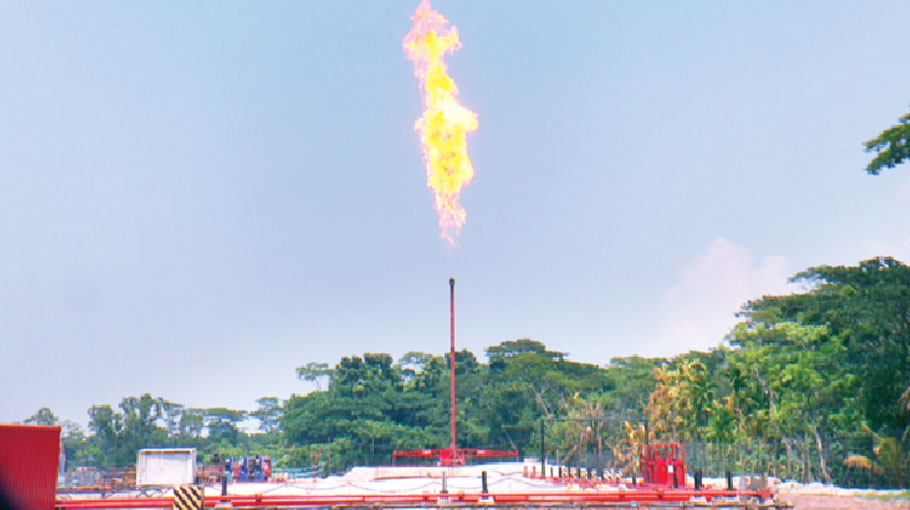Govt drills 17 gas wells in last two years
29 more to be drilled by 2025

The Department of Energy and Mineral Resources has set a target to drill 46 wells by 2025 given increasing the quantity of gas up to 620 million cubic feet per day.
In 2022 and 2023, 21 wells were supposed to be drilled. It is reported that just 9 percent of the total drilling work has so far been ompleted in the last 2.5 years. Petrobangla says the drilling process has already started for 17 wells, of which 9 are fully operational.
Concerning the government's efforts to address the current crisis by increasing domestic gas exploration and production, officials also insist that the delays in carrying out planned drilling operations are causing obstacles.
The daily gas demand stands at 380 million cubic feet, but the supply, averaging less than 250 million cubic feet for the past two months, falls short. The import-dependent strategy, initiated in 2018 with LNG imports, faced challenges in 2022 due to the US dollar crisis.
The challenges extend to offshore exploration in the Bay of Bengal, where, despite the resolution of maritime boundary disputes, there is a lack of progress in oil and gas exploration.
The government has approved a new Offshore Model Production Sharing Contract 2023 (PSC), the move is considered a milestone that would open the gates toward more exploration offshore Bangladesh.
But after six months, sharing gas with companies post-extraction has not translated into tender calls.
According to sources, only 9 wells have been drilled on time, indicating slow progress, and questions have been raised regarding whether the extraction target can be met by 2025.
Only one of Petrobangla Corporation's subsidiaries, BAPEX, can drill wells, most of the time they rely on contractors to handle the extraction of mineral resources.
According to Eng Md Kamruzzaman Khan, Director of Operations and Mines at Petrobangla, the whole drilling process situation cannot be explained by statistics and data, he told Bangladesh Post.
It is a continuous procedure. The rig setup, drilling, cementing and testing, well completion, fracking, production and recycling of fracking fluid, well abandonment, and land restoration are the steps that can be utilized to streamline the drilling process for both oil and natural gas.
He assured us that they are currently drilling 17 wells. 9 of these wells are fully functional and have begun to supply. "We have 1.5 years ahead of us to fulfil the target, and it is achievable," he continued.
State Minister for Power, Energy, and Mineral Resources Nasrul Hamid stated on Thursday that 112 million cubic feet of gas have been connected to the national grid as part of the 2023 exploration initiative.
One trillion cubic feet (Tcf) of natural gas reserves could be hidden in the recently drilled wells at the Bibiyana gas field in Bangladesh, according to a startling revelation made by the Ministry of Energy recently.
Furthermore bolstering this hopeful picture is the recently discovered Ilisha-1 gas field in the Bhola district, which stands as the nation's 29th gas field and is projected to contain a sizable reserve of 200 billion cubic feet (cf) of gas.
Sources said delays in drilling are attributed to a lingering approval process for development project proposals (DPPs), land acquisition, and machinery procurement.
The time-consuming nature of exploration and development wells, coupled with the challenges of implementation, necessitates considering simultaneous collaboration with multiple foreign companies to expedite drilling.
According to sources, BAPEX is aiming to drill 20 wells in four years and has only achieved half of its target, facing challenges in making some gas fields commercially viable. Sylhet Gas Fields Company and Bangladesh Gas Fields Company Limited have also encountered delays, with a shortfall in the completion of scheduled wells.
Foreign companies, including Russia's Gazprom, China's Sinopec, and Uzbekistan's Ariel Corporation, have been involved in drilling activities, prompting criticism for being awarded contracts without general tenders.
While the energy department argues that involving foreign companies is essential to accelerate drilling, concerns linger about BAPEX's capacity and accusations of increasing too much dependency on foreign expertise.
Compounding the issue, onshore gas field production is declining annually, and the US dollar crisis restricts the option of increasing gas imports. The nation is grappling with a gas crisis, evident from the recent shortages in six districts, including Chattogram, caused by technical faults at an imported liquefied natural gas (LNG) terminal.
Meanwhile, the Cabinet Committee on Government Purchase approved an import of 2.53 million metric tons of liquefied natural gas (LNG) from the global spot market last Tuesday.
Sources said, that from 2.53 million metric tons in 2018–2019 to 5.06 million metric tons in 2021–2022, the amount of imports has doubled.
Despite the government's effort to address the crisis by increasing gas prices in January 2023, the situation has not improved. Allegedly, traders are now burdened with higher prices, and the president of the Bangladesh Textile Mills Association (BTMA) reports that numerous factories have been forced to close, with more closures anticipated if the situation persists.
In 2012, Schlumberger Limited identified 49 gas wells with low production due to technical weaknesses, suggesting simple technical management (repairs, adjustments, and part additions) to enhance production rates. Experts argue that the recommendations never reflected accordingly.
Geologist and former Petrobanla Chairman Professor Badrul Imam said to the Bangladesh Post the unrealistic nature of the plan to extract domestic gas, emphasizing the adverse impact of import dependence on businesses and the general populace.
The prevailing gas crisis, coupled with the challenges in implementing drilling plans, underscores the urgency of addressing the underlying issues to ensure a sustainable and sufficient gas supply for the nation.




